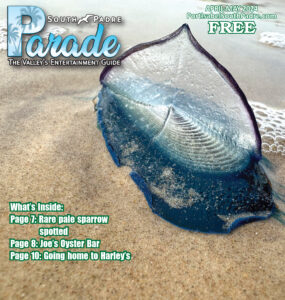By Steve Hathcock
Special to the Parade
Ellen Smith of Hot Springs, Arkansas sent me an email a while back asking about a bottle she and her husband had found while exploring near the mouth of the Rio Grande after Hurricane Dolly.
The bottle you found, I replied, is known as a ceramic, or stoneware, beer bottle. Depending on its condition, these bottles are generally worth from $18 to around $50. Some of the earlier specimens, though, can command a much higher premium.
In colonial days, beer was delivered in barrels and consumed at the tavern. As our country grew, so did the demand for beer. While bigger cities could support their own breweries by the 1860s, the smaller
outlying burgs had to have theirs hauled in by wagon. Shipping costs were prohibitive though, and bottling of beer came into fashion during the Civil War.
A friend of mine stumbled across the remains of an old cistern a couple years back while looking for Clarksville on the American side of the Rio Grande near the mouth (near where Smith and her husband found their bottle).
On a hunch, he began digging in the soft clay and before the day was finished, he had uncovered over 30 stoneware beer bottles, dozens of champagne bottles, an old inkwell, and a couple of almost intact pieces
of fine china.
The rarity of the day, though, was a small squatty emerald green bottle measuring about six inches in length. Embossed on one side is the name “E. McIntyre” and on the other side is “Mineral Water.”
What makes this particular bottle rare is the fact that McIntyre bottled his mineral water for only one year before selling out to F.A. Conant, who added the words “252 Girod Street New Orleans” to the bottles’
embossment.
Troops landing at Brazos Santiago during the onset of the Mexican War carried these little bottles in their knapsacks and it is not uncommon to find them at battlefield sites. An unbroken specimen in fine
condition could easily fetch upwards of $800 on today’s market. Bottles are worth more when they are clean and in near mint condition. Bottles like yours that have been buried in mud or underground for a
long time will usually be heavily stained from minerals contained in the ground water.
First, gently clean the bottle with a soft brush and warm soapy water. I like to use a spot free liquid soap such as used in a dishwasher. This will remove most of the dirt and crud. Many bottles will be quite
presentable at this point. If stains still persist, try Lime Away, Efferdent or Dexter’s to help in removing water stains. A word of caution, however, chemicals with muriatic acid can be dangerous to handle.
Professional bottle cleaners use tumblers and usually charge about $15 per bottle. If you are a rock hound and happen to have your own tumbler, using copper shot for several days will remove most, if not all, really hard stains.
Some bottles, such as old Civil War era champagne bottles, will take on a beautiful pearl-like swirling color. This patina comes from the lead foil the bottle was wrapped in and will have a tendency to easily flake off when attempting to clean it.
My friend Rod Bates, who owns an antique shop (Rio Bravo Gallery) located across the parking lot from the Port Isabel Library, is a noted authority on ancient bottles and is always happy to share his knowledge.



Comments